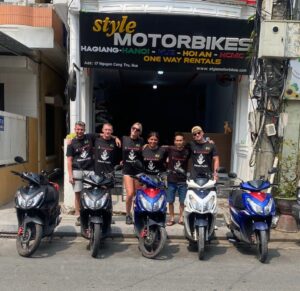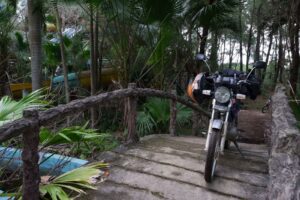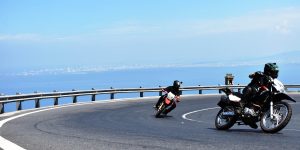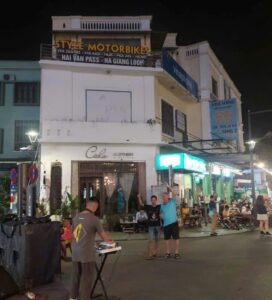Hue, Hue
Hue is located in the centre of Vietnam, it was the old provincial capital from 1687 to 1945. As such it is famed for the Imperial City, temple, tombs and palaces. This makes it a very popular tourist destination amongst visitors to Vietnam. During the summer it does get hot with average temperature reaching 30C, whilst the winter is still a nice average temperature at 24C but can get much colder. The wet season is from August – January, with the later of this being the worst. This results in spring being the best season for travelling, not so hot and dry.
Getting to Hue with Motorbike
South of Hue is Da Nang and Hoi An, both of which are just beyond the Hai Van Pass. Making this the common route south of Hue. One of the most famous stretches of road in the whole country, with mountains on side and the ocean on the other. It takes about 2 hours to reach the Hai Van Pass, which is next to Da Nang city and another hour and half from Hoi An. This will take all day with stops for the beach and views.
North of Hue is Khe Sanh, Phong Nha and Dong Hoi. Phong Nha is the most popular destination amongst these but heading via Khe Sanh and the Ho Chi Minh Road is by far the best way to reach it. Taking 2 days with a night in Khe Sanh takes you through some of the best riding in all of Vietnam, a quiet road weaves through the jungle of some of the most isolated parts of the country. Khe Sanh is just less than 200km with Phong Nha via Khe Sanh being just over 400km in total. If you are going with a motorbike this should be the only route north you are considering.
For those with little part of heading north then straight up the coast to Dong Hoi is possible but then you are missing out on some excellent roads and the unique caves at Phong Nha so this isn’t a route that is recommended. Dong Hoi is just 170km from Hue so is by the quickest route north.

Where to Stay
Being a large city there are plenty of options for accommodation in Hue so no need to book in advance as you will always be able to find somewhere.
If you are on a motorbike then you can easily reach any of the tourist destinations over Hue city which are quite spread out. Since the walking street in centre has good nightlife it is worth considering if you want to go in the evening to eat and drink and as such don’t want to ride the bike. In which case staying near the walking street is good.
There will be accommodation for all prices in Hue but it is good to know if they have space for bikes or if not that they have some parking nearby. This is usually not an issue in Hue as it is a large city but not that busy.

Imperial City
The Imperial City is the most famous sight in Hue. At 160 hectares and located in the centre of the city, it dominates the area. Surrounded by a moat and thick walls, along with a large flag pole at the entrance it is a striking image.
For those with the time or an interest for historical sights then this is a must visit. There is a 200k entrance fee which is well worth the price. Exploring all of the site can take a full day and during the summer it can get hot so it is best to arrive early.
For those with little time just visiting the main gate and flagpole will still give you a feel for the size and importance of this place but means you can be done very quickly.
Thien Mu Pagoda
Originally constructed in the 1600s and expanded multiple times since, this temple has grown large with a 7 story pagoda standing out. The pagoda became more historically relevant during the 1963 Buddhist crisis as part of the anti-government movement. The pagoda still houses an Austin car which Thich Quang Duc was driven in when he performed self-immolation during the Buddhist crisis. The photo of which became world famous, the Buddhist monk that burnt himself alive in protest.
Mausoleum of Emperor Tu Duc
The Mausoleum of Emperor Tu Duc was actually constructed by himself before his death and used as his residence. Located in a pine forest and with a large lake in front it covers a vast area which is very peaceful. There are 2 separate sections, the temple and tomb sections. One is dedicated to his life and worship while the other is dedicated to his resting place.
It is an impressive complex with multiple shrines and temples. Interestingly his body is actually not buried here. Scared of grave robbers he was buried somewhere within Hue, with the people that buried rumoured to have been killed afterwards to keep the location a secret.

Ho Quyen Arena
Built in 1830 which was used for elephant and tiger fights for the royal family. The elephants were seen as noble animals and well taken care of with stables in the area, while the tigers were savage beasts which killed people. As such the tigers were expected to lose, often declawed, injured or chained before the fight to ensure the elephants had the upper hand.
The site isn’t in a particularly good condition now and is not always accessible to the public but it is an interesting place to visit. If the stairs are open then you can access the top section and see into the arena.
Incense Village
As Hue was the capital and the royal family lived here they had a long standing tradition for incense. Located along the road you can see the incense displayed beautifully with multiple colours. They offer pictures here for a small fee with chairs set among the incense.
It is also possible to partake in workshops where you make incense or just souvenir shopping. Although these will not be high on the list for most people, riding pass is easy to do as it is located between other more interesting locations.

Abandoned Waterpark
The abandoned waterpark on the outskirts of the city has long been known for adventurous tourists that want to explore something more unusual. Access is not always guaranteed and something security will help for a tip.
In the centre of the park is a large dragon statue which you can climb via the stairs inside to view out through the mouth. This is in the centre of a lake, with a pathway all around. You can also find the old slides here as well.
It is in quite a bad state now as it has been years in which no one has taken care of it so if you are exploring only do so in the day and take care.

Hai Van Pass
The Hai Van Pass was the original famous motorbike ride in Vietnam thanks to Top Gear. It is still an amazing ride and very convenient due to Hue being to the north and Da Nang and Hoi An both being to the south. These are places that everyone usually visits on their trip to Vietnam and as such it is an easy one to ride even if this is the only ride.
With a perfect paved surface, mountains to one side and ocean views to the other it is easy to see why this is such a nice and popular ride. At the top of the pass are some cafes with nice views as well as an old fort.

Hue Walking Street
The walking street in Hue is the centre for bars, restaurants, nightlife and activities. This is especially true on the weekends when it is actually a walking street and closed for motorbikes and cars. Many locals will come to the area in the evening with their families and friends creating a very lively atmosphere.
There is plenty of restaurants with western or local food and many options for bars.
Summary
Hue is a must see for Vietnam and it is an easy place to visit when travelling between the north and the south. With excellent rides to the north and south it is a good place to visit with a motorbike. The city itself is full of history that is well worth seeing and know and quite different from the other nearby areas.
For most people they spend just one night here but that means missing out on a lot. This is the issue with their being so much to see in Vietnam. With 2 night so 1 full day you can visit the citadel, some pagoda or mausoleum and take in all the city has to offer.
Related Routes
For those heading between Hanoi and Hoi An or HCMC then Hue can also be included with the routes here. Also just for people doing the Hai Van Pass between Hue and Hoi An.
Reviews
Share your experience and help other ridersNo reviews yet. Be the first to review!

Leave a Comment & Review